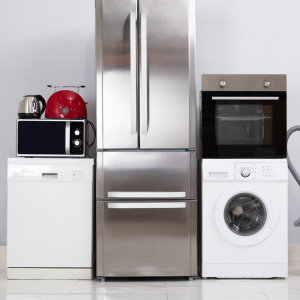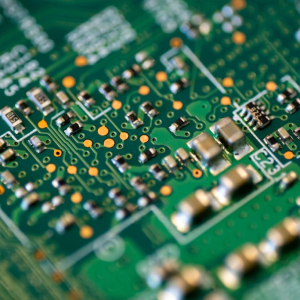
Robotics revolutionized many different industries, particularly manufacturing and related industries. In fact, 90% of robots work in manufacturing factories as part of industrial automation.
But robots require additional technologies to successfully complete their tasks. Robot sensors serve as key tools, enhancing industrial automation. In this article, we’ll discuss how robot sensors industrial operations and highlight the top 10 robot sensors enhancing industrial automation today.
Related: Getting the Most from Mectronic Part Search
How Do Robot Sensors Enhance Industrial Automation?
Most industrial robots use multiple different sensors, each with a specific purpose. Together, they allow the robot to maintain control and effectively operate in its environment.
These sensors provide the robot abilities necessary to interact with the environment. These ‘senses’ include touch, vision, balance, and more. With this information, a robot can make judgments and decisions even in complex situations.
1. Two-Dimensional Vision Sensor
As their name suggests, vision sensors serve as the robot’s eyes. Using a two-dimensional vision sensor, a type of smart camera, the robot “sees” where parts are. The sensors also detect moving objects, such as parts the robot might need on a conveyor belt.
Once equipped to detect where these objects are, robots complete useful applications with this location information. Programmed applications include moving parts to another location for sorting or initiating 3D printing on the part.
2. Three-Dimensional Vision Sensor
The three-dimensional vision sensor takes this ability to detect an object and allows the robot to see the object in 3-D. The sensor facilitates 3-D vision using two laser scanners or cameras placed at different angles.
With this added information, the robot can create 3D images and analyze parts in greater depth. Such analysis facilitates critical industrial applications such as more effective part picking or identification of counterfeit parts.
3. Navigation Sensor
Navigation sensors, or positioning sensors, allow the robot to know where it is. Most navigation sensors use GPS signals received and processed by a robot receiver from orbiting satellites. These signals identify the robot’s approximate position and velocity, telling the robot where it is and where it is going.
A robot with navigation sensors can move around in an environment independently. When combined with wireless power transmission, the robot can move independently indefinitely. Such a robot would be a valuable asset in a factory.
4. Gyroscope Sensor
Gyro sensors help the robot maintain its orientation. It does this by using the angular momentum principle. With the help of the sensor, the robot stabilizes itself independently of the earth’s gravity. Robots that spend time actively moving about or that have to carry unstable loads require enhanced stabilization abilities.

5. Sound Sensor
Simple sound sensors measure the amplitude of sounds around them, identifying how loud a noise is. This technology is similar to microphones connected to circuits and evaluates the sound based on identifying amplitude threshold values.
Modern sound sensors feature more complex abilities. Such sensors allow robots to hear and respond to commands given by the user.
If you’re looking for B2B components and parts then search over 2 billion products from many sources here!
6. Proximity Sensor
Some robots need the ability to sense a nearby object without touching it, such as applications requiring a robot to avoid collisions. Proximity sensors utilize electromagnetic radiation. In many cases, an infrared (IR) transceiver directs an IR beam using an LED. When (and if) the receiver senses any light, it creates an electrical signal. An additional receiver then analyzes signal interruptions. A smaller amount of light indicates the presence of an object. An uninterrupted signal indicates the absence of nearby objects and a clear path.
While IR sensors are popular, scientists also employ ultrasound sensors. Ultrasound sensors send out high-frequency sound waves and record any echoes. Echoes indicate the presence of a nearby object. These sensors also measure distances.
7. Touch Sensor
Contact sensors allow the robot to detect touch and avoid obstacles. Contact sensors are often found in micro-switches, limit switches, and other small devices. If the robot does not detect an obstruction, it can determine if it is safe to stop, turn, reverse, switch on, or make other movements.
Related: Electronics Industry Demonstrates Power of AI Technology
8. Force Sensor
Force sensors provide another depth to the robot’s sense of touch. This time, the force-torque sensor allows it to feel how much force the end effector applies. Usually, the sensor is installed between the fixture and the robot, allowing the robot to monitor the fixture’s forces.
These sensors tell the robot when it is gripping or releasing an object. They also help it work at a consistent speed. It also makes assembly, force limitation, and manual guidance easier.
9. Acceleration Sensor
Accelerometers measure the robot’s tilt and acceleration using two types of force: static forces and dynamic forces.
Scientists look at static force, a type of gravitational force, to identify how much the robot is tilting. Optimizing tilt improves a robot’s balance and communicates to the robot whether it is on an incline or a flat surface.
Scientists study dynamic force, using measurements of this force to equip the robot with the ability to identify its speed as it moves.
If you’re looking for B2B components and parts then search over 2 billion products from many sources here!
10. Temperature Sensor
Finally, temperature sensors measure temperature changes within the surrounding environment in numerous ways. Sensors monitor air, immersion, and surface temperatures depending on the application. Each measurement requires a different method. For example, some create changes in resistance, while others use changes in voltage through a semiconductor junction.

Improve Industrial Automation with Robot Sensor Systems
Robot sensors ensure industrial robots sense and perform within their environments. Sensors provide necessary information for safer operation, enhancing industrial robots, and improving task completion and efficiency.
Related: Rethinking Circuits And Electronic Devices With Printed Electronics
Interested in the latest trends and innovations in technology? The Mectronic blog is your source for trusted insight into the technology world. Check our blog for regular updates!

Mectronic has been connecting sellers and buyers for 25 years. With powerful search tools and over 300 million products, Mectronic helps you find the B2B components you need from sources you trust. Find the parts and components you need today here!





